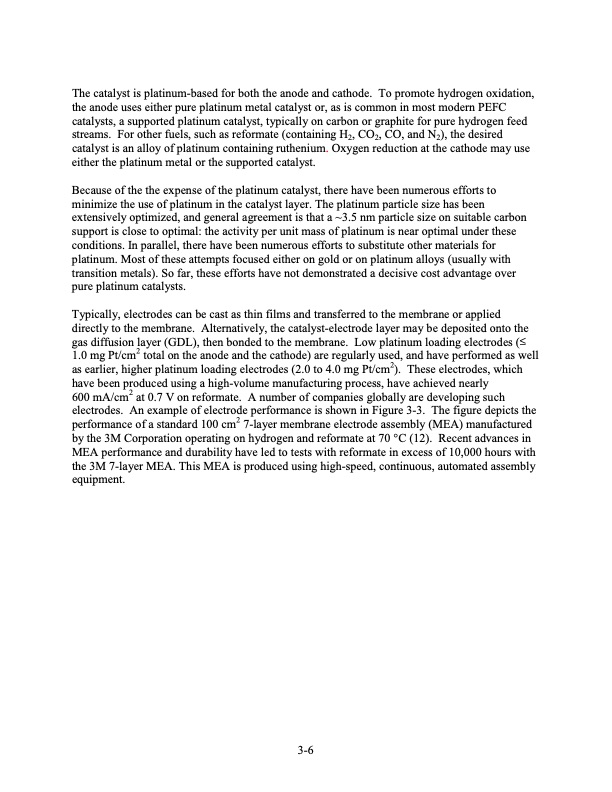
PDF Publication Title:
Text from PDF Page: 093
The catalyst is platinum-based for both the anode and cathode. To promote hydrogen oxidation, the anode uses either pure platinum metal catalyst or, as is common in most modern PEFC catalysts, a supported platinum catalyst, typically on carbon or graphite for pure hydrogen feed streams. For other fuels, such as reformate (containing H2, CO2, CO, and N2), the desired catalyst is an alloy of platinum containing ruthenium. Oxygen reduction at the cathode may use either the platinum metal or the supported catalyst. Because of the the expense of the platinum catalyst, there have been numerous efforts to minimize the use of platinum in the catalyst layer. The platinum particle size has been extensively optimized, and general agreement is that a ~3.5 nm particle size on suitable carbon support is close to optimal: the activity per unit mass of platinum is near optimal under these conditions. In parallel, there have been numerous efforts to substitute other materials for platinum. Most of these attempts focused either on gold or on platinum alloys (usually with transition metals). So far, these efforts have not demonstrated a decisive cost advantage over pure platinum catalysts. Typically, electrodes can be cast as thin films and transferred to the membrane or applied directly to the membrane. Alternatively, the catalyst-electrode layer may be deposited onto the gas diffusion layer (GDL), then bonded to the membrane. Low platinum loading electrodes (≤ 1.0 mg Pt/cm2 total on the anode and the cathode) are regularly used, and have performed as well as earlier, higher platinum loading electrodes (2.0 to 4.0 mg Pt/cm2). These electrodes, which have been produced using a high-volume manufacturing process, have achieved nearly 600 mA/cm2 at 0.7 V on reformate. A number of companies globally are developing such electrodes. An example of electrode performance is shown in Figure 3-3. The figure depicts the performance of a standard 100 cm2 7-layer membrane electrode assembly (MEA) manufactured by the 3M Corporation operating on hydrogen and reformate at 70 °C (12). Recent advances in MEA performance and durability have led to tests with reformate in excess of 10,000 hours with the 3M 7-layer MEA. This MEA is produced using high-speed, continuous, automated assembly equipment. 3-6PDF Image | Fuel Cell Handbook (Seventh Edition)

PDF Search Title:
Fuel Cell Handbook (Seventh Edition)Original File Name Searched:
fuel-cell-handbook.pdfDIY PDF Search: Google It | Yahoo | Bing
NFT (Non Fungible Token): Buy our tech, design, development or system NFT and become part of our tech NFT network... More Info
IT XR Project Redstone NFT Available for Sale: NFT for high tech turbine design with one part 3D printed counter-rotating energy turbine. Be part of the future with this NFT. Can be bought and sold but only one design NFT exists. Royalties go to the developer (Infinity) to keep enhancing design and applications... More Info
Infinity Turbine IT XR Project Redstone Design: NFT for sale... NFT for high tech turbine design with one part 3D printed counter-rotating energy turbine. Includes all rights to this turbine design, including license for Fluid Handling Block I and II for the turbine assembly and housing. The NFT includes the blueprints (cad/cam), revenue streams, and all future development of the IT XR Project Redstone... More Info
Infinity Turbine ROT Radial Outflow Turbine 24 Design and Worldwide Rights: NFT for sale... NFT for the ROT 24 energy turbine. Be part of the future with this NFT. This design can be bought and sold but only one design NFT exists. You may manufacture the unit, or get the revenues from its sale from Infinity Turbine. Royalties go to the developer (Infinity) to keep enhancing design and applications... More Info
Infinity Supercritical CO2 10 Liter Extractor Design and Worldwide Rights: The Infinity Supercritical 10L CO2 extractor is for botanical oil extraction, which is rich in terpenes and can produce shelf ready full spectrum oil. With over 5 years of development, this industry leader mature extractor machine has been sold since 2015 and is part of many profitable businesses. The process can also be used for electrowinning, e-waste recycling, and lithium battery recycling, gold mining electronic wastes, precious metals. CO2 can also be used in a reverse fuel cell with nafion to make a gas-to-liquids fuel, such as methanol, ethanol and butanol or ethylene. Supercritical CO2 has also been used for treating nafion to make it more effective catalyst. This NFT is for the purchase of worldwide rights which includes the design. More Info
NFT (Non Fungible Token): Buy our tech, design, development or system NFT and become part of our tech NFT network... More Info
Infinity Turbine Products: Special for this month, any plans are $10,000 for complete Cad/Cam blueprints. License is for one build. Try before you buy a production license. May pay by Bitcoin or other Crypto. Products Page... More Info
| CONTACT TEL: 608-238-6001 Email: greg@infinityturbine.com | RSS | AMP |